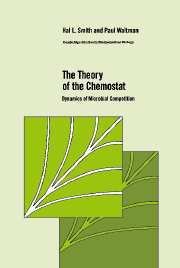Book contents
- Frontmatter
- Contents
- Preface
- 1 The Simple Chemostat
- 2 The General Chemostat
- 3 Competition on Three Trophic Levels
- 4 The Chemostat with an Inhibitor
- 5 The Simple Gradostat
- 6 The General Gradostat
- 7 The Chemostat with Periodic Washout Rate
- 8 Variable-Yield Models
- 9 A Size-Structured Competition Model
- 10 New Directions
- 11 Open Questions
- Appendices
- References
- Author index
- Subject index
Preface
Published online by Cambridge University Press: 07 December 2009
- Frontmatter
- Contents
- Preface
- 1 The Simple Chemostat
- 2 The General Chemostat
- 3 Competition on Three Trophic Levels
- 4 The Chemostat with an Inhibitor
- 5 The Simple Gradostat
- 6 The General Gradostat
- 7 The Chemostat with Periodic Washout Rate
- 8 Variable-Yield Models
- 9 A Size-Structured Competition Model
- 10 New Directions
- 11 Open Questions
- Appendices
- References
- Author index
- Subject index
Summary
The chemostat is a basic piece of laboratory apparatus, yet it occupies a central place in mathematical ecology. Its importance stems from the many roles it plays. It is a model of a simple lake, the ideal place to study competition in its most primitive form – exploitative competition. It is also used as a model of the wastewater treatment process. In its commercial form the chemostat plays a central role in certain fermentation processes, particularly in the commercial production of products by genetically altered organisms (e.g., in the production of insulin). The theoretical literature is scattered; papers appear in mathematical, biological, and chemical engineering journals. In addition to being known as a chemostat, other common names are “continuous culture” and, in the engineering literature, CSTR (continuously stirred tank reactor). This monograph is devoted to the theoretical description of ecological models based on the chemostat and to problems that can be described in that context, drawing from literature in all fields and presented within a common framework and with consistent notation.
In order to understand the mathematical importance of the chemostat, one must look at the broader picture of the subject of nonlinear differential equations. Linear differential equations have been studied for more than two hundred years; their solutions have a rich structure that has been well worked out and exploited in physics, chemistry, and biology. A vast and challenging new world opens up when one turns to nonlinear differential equations.
- Type
- Chapter
- Information
- The Theory of the ChemostatDynamics of Microbial Competition, pp. xi - xviPublisher: Cambridge University PressPrint publication year: 1995

